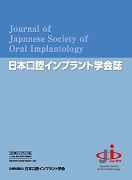Current issue
Displaying 1-12 of 12 articles from this issue
- |<
- <
- 1
- >
- >|
Review
-
Article type: Review
2025 Volume 38 Issue 2 Pages 61-69
Published: June 30, 2025
Released on J-STAGE: July 20, 2025
Download PDF (1015K)
Special Articles:Dental Treatment to Prevent Further Tooth Loss, What We Know Now and What We Should Do in the Future
-
Article type: Special Articles: Dental Treatment to Prevent Further Tooth Loss, What We Know Now and What We Should Do in the Future
2025 Volume 38 Issue 2 Pages 70
Published: June 30, 2025
Released on J-STAGE: July 20, 2025
Download PDF (498K) -
Article type: Special Articles:Dental Treatment to Prevent Further Tooth Loss, What We Know Now and What We Should Do in the Future
2025 Volume 38 Issue 2 Pages 71-77
Published: June 30, 2025
Released on J-STAGE: July 20, 2025
Download PDF (748K) -
Article type: Special Articles:Dental Treatment to Prevent Further Tooth Loss, What We Know Now and What We Should Do in the Future
2025 Volume 38 Issue 2 Pages 78-87
Published: June 30, 2025
Released on J-STAGE: July 20, 2025
Download PDF (3991K) -
Article type: Special Articles:Dental Treatment to Prevent Further Tooth Loss, What We Know Now and What We Should Do in the Future
2025 Volume 38 Issue 2 Pages 88-95
Published: June 30, 2025
Released on J-STAGE: July 20, 2025
Download PDF (1475K)
Original Papers
-
Article type: Original Papers
2025 Volume 38 Issue 2 Pages 96-104
Published: June 30, 2025
Released on J-STAGE: July 20, 2025
Download PDF (1838K)
Original Papers
-
Article type: Original Papers
2025 Volume 38 Issue 2 Pages 105-114
Published: June 30, 2025
Released on J-STAGE: July 20, 2025
Download PDF (2087K) -
Article type: Original Papers
2025 Volume 38 Issue 2 Pages 115-126
Published: June 30, 2025
Released on J-STAGE: July 20, 2025
Download PDF (1774K)
Case Reports
-
Article type: Case Reports
2025 Volume 38 Issue 2 Pages 127-132
Published: June 30, 2025
Released on J-STAGE: July 20, 2025
Download PDF (1063K) -
Article type: Case Reports
2025 Volume 38 Issue 2 Pages 133-139
Published: June 30, 2025
Released on J-STAGE: July 20, 2025
Download PDF (1546K) -
Article type: Case Reports
2025 Volume 38 Issue 2 Pages 140-144
Published: June 30, 2025
Released on J-STAGE: July 20, 2025
Download PDF (962K) -
Article type: Case Reports
2025 Volume 38 Issue 2 Pages 145-155
Published: June 30, 2025
Released on J-STAGE: July 20, 2025
Download PDF (3123K)
- |<
- <
- 1
- >
- >|
